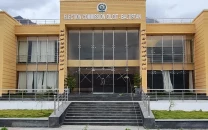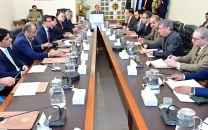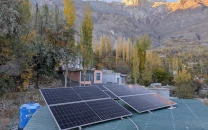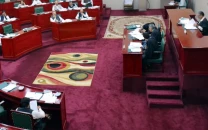Untapped resources: Project launched to buff up G-B’s gemstone industry
Two training centres established in Chitral and Hunza.

“With appropriate value addition skills such as the right cuts and finishing of gemstones, the sector has immense potential to contribute to the country’s economy,” said Rupani’s chief. GRAPHIC: JAMAL KHURSHID
A new project for Gilgit-Baltistan’s (G-B) gemstone industry was inaugurated in Hunza valley on Saturday.
‘Technology Transfer and Skill Development in Gems Sector’ is a two-year project funded specifically by Small Grants and Ambassador’s Fund of USAID and will be executed by Rupani Foundation, a non-governmental organisation working for socio-economic development in the mountainous regions of South Asia.
“It’s a good initiative and we hope people will benefit from it,” G-B Assembly Speaker Wazir Baig said while speaking at the inauguration ceremony in Aliabad, Hunza.
The first gemstone mine in Gilgit was discovered in 1951. Since then, locals have been engaged in exploration, extraction and exploitation activities albeit informally.
According to estimates, there are over 60 different types of precious and semi-precious stones, with more than 8,000 people involved in artisanal mining. This is why G-B is considered a ‘treasure trove’ of gemstones with ruby, emerald, topaz, aquamarine, sapphire, and tourmaline said to be in abundance.

“It is aimed at creating jobs with special focus on skill development among women and poor people.” said Chief Executive Rupani Foundation Jalaluddin while sharing details about the project. “It will increase the mobility of women and access to cash income.”
Two well-equipped training centres with state-of-the-art machinery have been set up in Chitral and Hunza valley where a Sri Lankan master trainer will train 20 others – 10 from Chitral and Hunza each. After graduating from the six-month course, these master trainers will further train 10 individuals each during the next six months, taking the total number of professionals to 200.
Jalaluddin explained the best lot of trainers will be provided cutting machines, which people will use to work from home or training centres. “This way the centres will gradually turn into semi-workshops and facilitate individuals who want to work in the field,” he added.
According to Jalaluddin, Pakistan has not been able to benefit from its natural resources due to lack of skills, technology, knowledge of processing mining material and then taking it to national and international markets.
He emphasised on immediate intervention to develop expertise in cutting and polishing gems, capacity to make products locally and, finally, linking them to the correct markets.
“With appropriate value addition skills such as the right cuts and finishing of gemstones, the sector has immense potential to contribute to the country’s economy,” said Rupani’s chief.
He added precious and semi-precious stones are presently sold for a fraction of their actual price through middlemen in Peshawar, and then exported to India, Sri Lanka, Thailand and European countries. “Interestingly, the same stones are imported back into Pakistan after value additions,” said Jalaluddin.
Published in The Express Tribune, August 25th, 2013.



















COMMENTS
Comments are moderated and generally will be posted if they are on-topic and not abusive.
For more information, please see our Comments FAQ